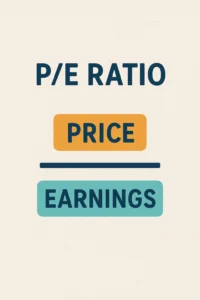Price to Earnings P/E Calculator
P/E Calculator: Price Earnings Ratio Calculator for Stocks.
Price to Earnings P/E Calculator
Insert the Stock Price and the Earnings per Share (earnings divided by shares outstanding). Alternatively divide the market capitalization by total earnings.
They can be found via a Google search, in the annual report on the company’s website under “Investors Relations” or on relevant stock portals.
In our Premium Tool, a large number of different evaluation models are used and the required data is loaded automatically.
What is the Price to Earnings P/E Calculator?
The Price to Earnings (P/E) Ratio is a relative valuation metric used to determine wether a stock is overvalued or undervalued. It divides the stock price by the earnings per share. Always try to compare the P/E to the company’s peers, its historic average or the overall industry average. The longterm P/E average for the S&P 500 since 1870 is 15. A P/E below 15 is considered as good. The P/E shows how much you have to pay for 1 unit of profit. The less the better. Beside our P/E Calculator we deliver many other valuation calculators.
The Price-to-Earnings (P/E) ratio shows how much investors are willing to pay for one unit of earnings. Use this P/E Ratio Calculator (also called a price earnings ratio calculator or PE calculator) to turn stock price and EPS into a clear multiple within seconds. It’s a fast way to benchmark valuation before you dive deeper with advanced models.
Formula Price to Earnings P/E Calculator:
P/E equals the price per share divided by earnings per share. You can reach the same result by dividing market capitalization by net income, with EPS defined as net income over shares outstanding. The logic is straightforward: higher prices or lower earnings push the multiple up, and the inverse pulls it down.
Type the current stock price, add EPS—either trailing twelve months or a forward estimate—and hit calculate. The tool instantly returns the multiple and keeps the inputs visible so you can test scenarios, compare versions of EPS, and sanity-check valuation against peers.
P/E Ratio = Stock Price / Earnings per Share
P/E Ratio = Market Capitalization / Company’s Earnings
Top 10 Stocks: High Profitability Strategy
This list is updated daily by our Stock Screener Tool, covering more than 60,000 stocks worldwide. Discover this and many other Top-Lists inside the Fairvalue Calculator Premium Tool – try it now for free!
Example P/E Calculator:
Let’s look at the P/E of Walmart Inc. which is one of the largest chain of supermarkets in the world alongside its peers Costco Wholesale and Target Corp as well as the industry average.

As you can see the P/E of Target Corp. is half of industry average as well as its peers. It is undervalued when compared to its peers because you only pay 18.27$ per dollar of profit as compared to the average 36,24$. The higher the earnings and the lower the price the lower the P/E, which is good. Now let us look at the performance after one year:
Target Corp. generated a massive 92% return. It has experienced a sharp increase in share price which was followed by an increase in earnings as well. Walmart and Costco on the other hand have not done quite as well. There is a lot of potential for further increase in the price of Target Corp. as even if its earnings remain the same, for its P/E reach fair value, its share price will have to nearly double again from this point.
What you should be looking for:
What about growth?
P/E ratios of cyclical businesses do not reflect the cyclical nature of certain businesses like commodities. A metal company will have a low P/E at the top of the metal pricing cycle which might come across as undervalued but is actually overvalued as the downward segment of the cycle will reduce earnings thus sharply increasing the P/E. Thus P/E becomes an unreliable metric when evaluating cyclical stocks Other minor drawbacks include backward looking measure, no integration of negative earnings etc.
Conclusion P/E Caluclator:
The P/E Calculator is a nice tool to calculate and to understand a valuation metric that can help sift through companies and shortlist undervalued companies. However it is not a standalone metric to decide valuation. One must look at other metrics like Price to Book value and Price to sales as well alongside other metrics.
We have over 12 such key financial ratio calculators on our website, all available for free. Calculate the key ratios and build a consensus through them to determine whether a company is truly undervalued or overvalued.
The P/E Calculator is a pretty nifty tool to shorten a wide list of stocks immediately. By going through the sector list, look at the undervalued sectors and then simply filter out those that have a P/E higher than average. Once the undervalued company list is ready, use other key ratios to build a consensus (For e.g. 7 out of 10 key ratios indicate undervaluation which is a pretty good sign) and drill down on various fundamental aspects of the businesses to make an informed investment decision.
P/E Calculator — FAQs
Quick answers about the Price-to-Earnings ratio and how to use this calculator effectively.

